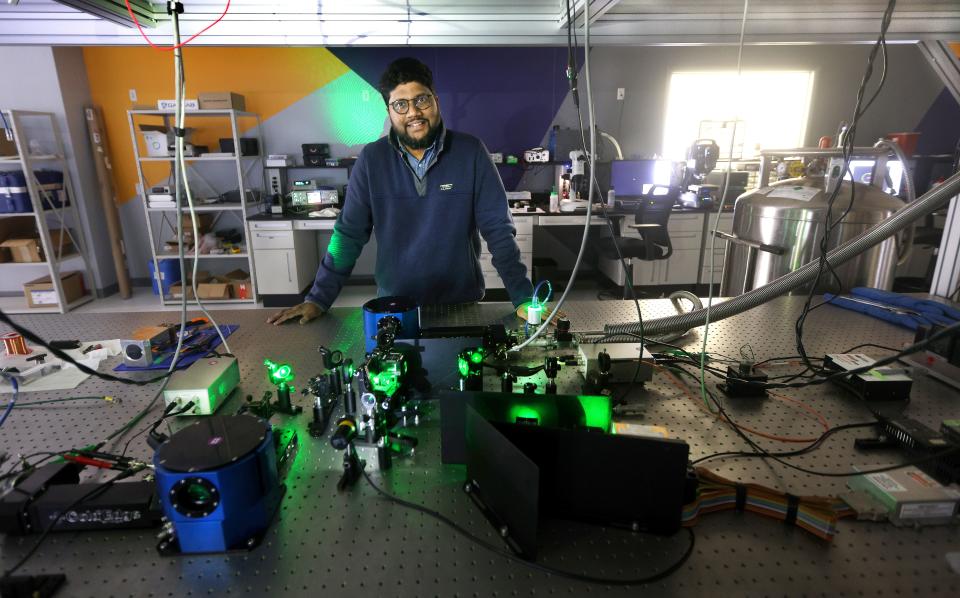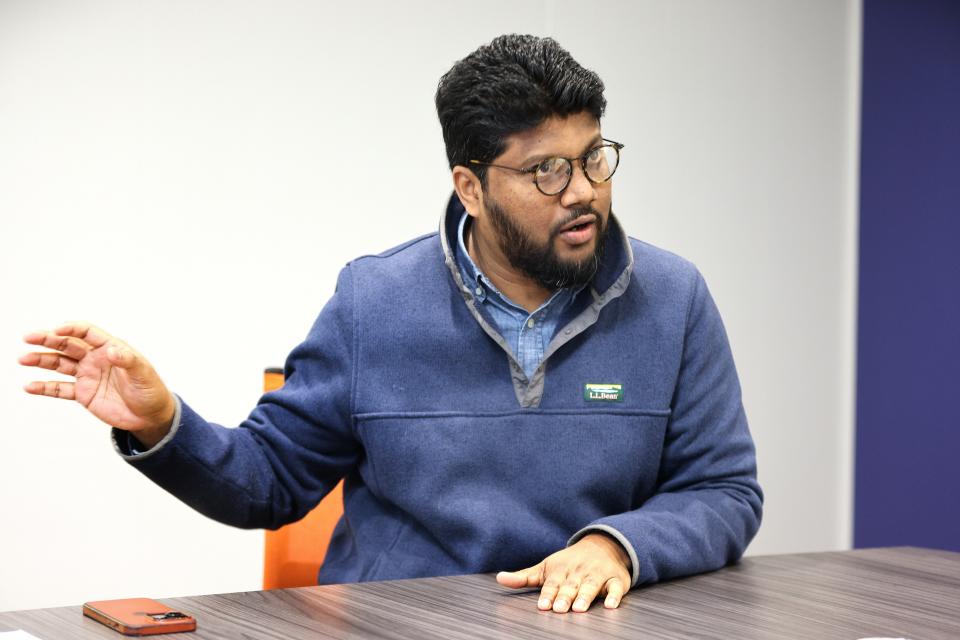UR physicist Ranga Dias says he's made a world-altering discovery. Others say he made it up.
No friction. That's what Ranga Dias is after.
The University of Rochester physicist spends most of his days in a private lab on Blossom Road, tirelessly chasing after a feat he says he's already accomplished: ambient superconductivity, where electricity can move without resistance at room temperature and under relatively normal atmospheric pressure.
Unlocking that accomplishment would change the world. Energy would be cheap and abundant; computer chip technology would advance by light years.
Dias has recruited scientists and analysts from around the world and has obtained $17 million in venture capital funding. They are committed to nailing down precisely how a material they call Reddmatter is able to free electrons from otherwise impregnable laws of conductivity.
"The science is real," Dias said in a recent D&C interview, one of the few he has granted in the last year. "The science is there. ... This is the beginning."
Other leading physicists believe his approach could theoretically prove correct — but they want to see the data that proves it. Therein lies the friction.

Dias is working at his private lab and not at the UR in large part because he's been ostracized from the university and the world of academic physics at large. His series of scientific papers trumpeting magnificent advances have been retracted over allegations of fraud. A recent review commissioned by UR determined he had engaged in research misconduct and recommended that he be fired.
The broad scientific consensus, including among his employer and his former students and collaborators, is that Dias fabricated or misrepresented his data.
"It's just complete (BS)," said N. Peter Armitage, a physicist at John Hopkins University. "All the papers had problems. ... (His) students have said the data wasn’t taken, and the analysis on other data was completely fraudulent. That’s the story."
Achieving the impossible
A superconductor that works at room temperature and relatively low pressure — outside a specialized lab, in other words — would be one of the outstanding scientific advances in human history.
Creating non-polluting energy through nuclear fusion would become vastly simpler and cheaper, allowing for a rapid transition away from fossil fuels. Trains could levitate above the tracks thanks to powerful magnetism, cutting resistance almost to zero. Frictionless transmission between superconducting computer chips, or across superconducting power lines, would revolutionize communication and energy transmission.
Dias created a frenzy in 2020 with the claim that he'd solved half of the problem, creating superconductivity at room temperature but still under immense pressure.
That paper, published in the prestigious journal Nature, was retracted two years later after outside physicists reported irregularities with the data. Dias and his co-authors objected to the retraction and UR at the time stood behind him after an internal review.
He continued with his research and in 2023 announced an even more noteworthy accomplishment, again published in Nature. This time, Dias said he had achieved the seemingly impossible: superconductivity at room temperature and low pressure. The key innovation was his use of a rare earth metal called lutetium hydride, dosed with a small amount of nitrogen. He named the material Reddmatter.
“He really could be the best high-pressure physicist in the world, poised to win the Nobel Prize," one peer scientist told the New York Times in 2023. "Or there’s something else going on.”
Within days, other physicists were raising objections to Dias' new claims. They found unusual patterns in the data indicating possible tampering or fabrication. Graduate students who had worked on the experiments in Dias' labs joined other co-authors in asking Nature to retract the article, saying there had been a "lack of transparency ... (and) scientific diligence" inside Dias' lab.

Less than a week after the landmark paper was published in March 2023, the National Science Foundation, which sponsored some of Dias' work, asked UR to investigate the allegations of misconduct.
That paper was retracted, too. So were three other published papers, for a total of five.
Critics also have noticed passages of text in Dias' doctoral dissertation and other published works that were copied nearly verbatim from other authors' work, instances that Dias dismissed as inadvertent, trivial or owing to earlier difficulties as an English language learner.
'He cannot be trusted'
An internal review of the sort that UR commissioned in 2023 typically would remain confidential. It was made public earlier this year, though, in a legal filing related to Dias' active lawsuit against the university. He is asking a judge to force UR to convene a grievance committee "related to academic freedom."
The three outside physicists who wrote the report criticized Dias harshly. They accused him of falsifying and fabricating data and said he had failed to provide the proper raw data for peers to attempt to replicate his findings.
"The Investigation Committee recommends that (Dias) not be permitted to teach students, to mentor students, or to supervise students at any level ... or to carry out independent research funded by government agencies or private entities (whether industry or philanthropic)," they wrote. "Evidence uncovered in this investigation shows that (he) cannot be trusted."
UR accepted the report and stripped Dias of his students and teaching responsibilities, though he still has access to his lab. In a legal filing, the university said it has asked the internal Committee on Tenure and Privileges to terminate Dias, who does not have tenure.
Dias provided a 175-page response to the investigators, then added more than 100 pages of additional comments after their finding was released. The damning report, he said, reflected "a series of misunderstandings and misapplications of scientific standards and methodologies" and ignored exculpatory evidence.
"The path to scientific discovery is fraught with challenges, yet it is through these adversities that we refine our methodologies, strengthen our convictions, and contribute to the vast tapestry of human knowledge," he concluded. "Let us proceed with a shared dedication to truth, integrity, and the relentless pursuit of scientific excellence."
In an interview, Dias acknowledged that he'll never teach again at UR.
"My experience in the last four years has been very, very bitter," he said. "I'm sure they want me to be gone, and I don't want to be there either."
The journal Nature has come in for harsh criticism after publishing two of Dias' papers, in particular the second one. Armitage, the Johns Hopkin University physicist, said UR too had committed a "dereliction of duty" by not heeding earlier warnings about Dias' research.
He noted in particular a 2023 video the university created to promote his superconductivity claims.
"I think UR's behavior has been grotesque," he said. "They clearly wanted this to be true at all levels of the organization. ... They had dollar signs in their eyes."
Slow and lonely work
What if Dias is right?
He has mostly avoided interviews in the last year but has stated his case at great length in court documents as well as a memo to his UR colleagues.
The retractions, he says, were the result of novel and misunderstood methodologies; a sort of mutiny instigated by two "dissatisfied" graduate students; and the university abandoning him for public relations reasons rather than scientific ones. Dias has ample documentation related to each of these points, but the internal reviewers — who he says had conflicts of interest that should have disqualified them — found it unconvincing.
As for the research question itself, Dias and his partners at Unearthly Materials are certain they're right.
"If you read the theoretical papers, it was almost a natural conclusion," Chief Technology Officer Ron Sellam said. "We know the theory says there will be superconductivity. The only question is how to synthesize a proper sample of it."
Work at the lab on Blossom Road has focused lately on the question of how to develop additional samples of Reddmatter that will have the same superconducting effect Dias said he observed previously. That means reverse engineering from the small and degrading sample they already possess.
It is slow and lonely work, done in isolation from the scientific community at large. Whoever controls the key technology behind a superconductivity breakthrough, though, would stand to profit handsomely.
Unearthly Materials has a current valuation of $200 million, Dias said, based mostly on a $15 million investment from the European venture capital firm Plural. He foresees an upstate New York superconductivity nexus including Cornell University and the University of Buffalo.
There are also two relevant patents, both based on Dias' work at the UR and therefore owned by the university. The applications are currently pending at the U.S. Patent and Trademark Office.
This is a major source of frustration for Dias: UR has disavowed his research everywhere except the one place where it stands to enrich itself in the event that he is vindicated.
"If the paper has fabricated data, the patent application has fabricated data," he said. He has asked UR to release the patents to him if it doesn't support the underlying research.
In a statement, UR spokeswoman Sara Miller said the university is "in the process of re-evaluating the University’s relationship to Professor Dias’ intellectual property, patents and business activities, and intends to divest those interests whose scientific validity is now in serious doubt."
All of this — the retractions, having his name besmirched, possibly losing his professorship — is "noise in the background," Dias said. He believes in his research and his methods and is confident he will be vindicated in the end.
"The one thing that keeps me going is that I know the science," he said. "I know what I see. ... I just need time to prove it."
— Justin Murphy is a veteran reporter at the Democrat and Chronicle and author of "Your Children Are Very Greatly in Danger: School Segregation in Rochester, New York." Follow him on Twitter at twitter.com/CitizenMurphy or contact him at jmurphy7@gannett.com.
This article originally appeared on Rochester Democrat and Chronicle: Ranga Dias, University of Rochester physicist, discovery questioned

